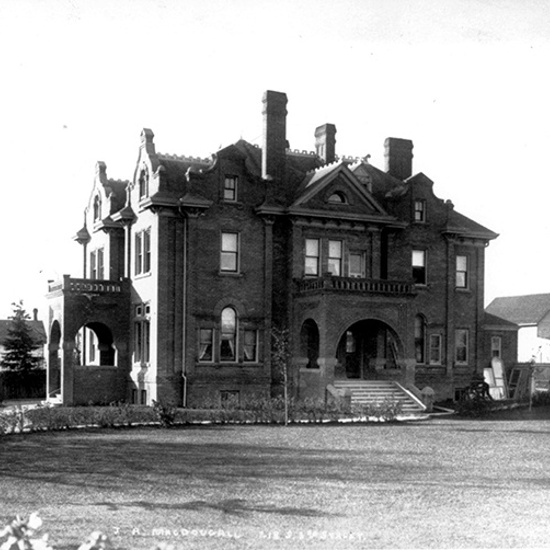McDougall Mansion
Built for John A. McDougall, the McDougall Mansion was designed in the Tudor architectural style.
Built for John A. McDougall, the McDougall Mansion was designed in the Tudor architectural style.
Designed by local architects William S. Edmiston and Henry D. Johnson, construction began on the McDougall Mansion in 1898 and finished in 1899. This two and one-half storey Tudor home included nine bedrooms, a drawing room, a library, a dining room, a kitchen, and a billiard room. The property housed a stable, tennis courts, and formal gardens in the back. The home was built in a distinct subset of the Tudor style know for its shaped Flemish gables, and lack of half timbering. Like most other examples of Tudor styles, the home had a steeply-pitched intersecting gable roof, intricate brick and stone work, prominent chimneys, elaborate façade detailing, and tall narrow windows.
This mansion was constructed for John A. McDougall, a businessman, speculator and politician who arrived in Edmonton in 1879. John A. McDougall served as Mayor of Edmonton in 1897 and 1907, and was co-founder of McDougall and Secord General Merchants. The merchants hold a dubious place amongst First Nations and Métis peoples, with the business playing a key role in damaging policies like Scrip speculation. He originally purchased the land in September of 1895 and occupied the home with his family from its construction in 1899 until 1928.
While the mansion was occupied by the McDougall family it came to be known as one of the leading centres of Edmonton's social life within the city's higher social circles. Following John A. McDougall's death in 1928, his wife and later his sons occupied the home until 1946. Between 1946 and 1967 the McDougall Mansion was occupied by the Edmonton Home for Ex-Service Men's Children under the direction of the Imperial Daughters of the Empire (I.O.D.E.). In 1968 the Young Women's Christinan Association (YWCA) operated the home as a women's rehabilitation centre. The McDougall Mansion was demolished in 1974 and replaced by a new structure for the YWCA. The site is now home to a 14 storey apartment building.
Details
Type
Residential
Designation Status
Demolished
Neighbourhood
Time Period
Year Built
1899
Architects
Architectural Styles
Character Defining Elements
Balcony , Brackets , Brick cladding , Brick structure , Corbelling , Cornice , Cross gable roof , Dormer , Finial , Irregular footprint , Keystone , Lintel , Pilaster , Portico , Two & a half storeys , Voussoirs , Wooden shingles
